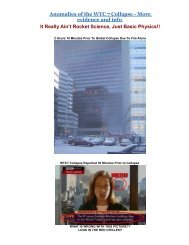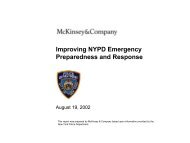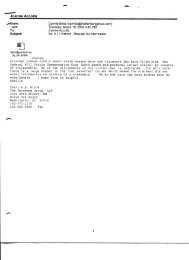The Big Lie 9-11 and Government Complicity in Mass Murder [PDF]
The Big Lie 9-11 and Government Complicity in Mass Murder [PDF]
The Big Lie 9-11 and Government Complicity in Mass Murder [PDF]
Create successful ePaper yourself
Turn your PDF publications into a flip-book with our unique Google optimized e-Paper software.
<strong>The</strong> <strong>Big</strong> <strong>Lie</strong>” 9/<strong>11</strong> <strong>and</strong> the <strong>Government</strong>’s<br />
<strong>Complicity</strong> <strong>in</strong> <strong>Mass</strong> <strong>Murder</strong><br />
239<br />
164 Barnett, Antony. “UK firm tried HIV drug on orphans.” <strong>The</strong> Guardian Unlimited. 4 April 2004. 19<br />
Sept. 2005 <br />
Doran, Jamie “New York’s HIV experiment.” BBC News, UK Edition. 30 Nov. 2004. 19 Sept. 2005<br />
<br />
165 Barnett, Antony. “UK firm tried HIV drug on orphans.” <strong>The</strong> Guardian Unlimited. 4 April 2004. 19<br />
Sept. 2005 <br />
Doran, Jamie “New York’s HIV experiment.” BBC News, UK Edition. 30 Nov. 2004. 19 Sept. 2005<br />
<br />
166 Annie, 1982. <br />
167 Dr. Stanley Milgram’s experiments <strong>in</strong> human response to authority <strong>in</strong> the 1960’s-70's offer as much<br />
<strong>in</strong>sight today as when they were orig<strong>in</strong>ally conducted. <strong>The</strong> experiments are best known as a series of<br />
tests performed through Yale University, where a subject was told to adm<strong>in</strong>ister an <strong>in</strong>creas<strong>in</strong>gly high<br />
level of electrical shock to a victim (an actor) attempt<strong>in</strong>g to learn a series of word relationships. <strong>The</strong><br />
experiments were all variations on a theme: a unknow<strong>in</strong>g participant (the subject-teacher) was<br />
brought to believe that s/he was participat<strong>in</strong>g <strong>in</strong> a learn<strong>in</strong>g study. <strong>The</strong> other two ma<strong>in</strong> participants<br />
were a man who posed as the student (the learner) <strong>and</strong> one who posed as the pr<strong>in</strong>cipal <strong>in</strong>vestigator<br />
(the authority figure). <strong>The</strong> subject-teacher was told that the learn<strong>in</strong>g would occur <strong>in</strong> this way: the<br />
student would be hooked up to an electric shock generator while the teacher would read a set of word<br />
pairs, which the student would repeat back. When the student missed one of the word pairs, he would<br />
be shocked by the "teacher" <strong>in</strong> <strong>in</strong>creas<strong>in</strong>gly higher shocks (the shocks <strong>in</strong>creased <strong>in</strong> 15 volt <strong>in</strong>crements),<br />
up to 450 volts (which was marked, along with the 435 volt mark, with XXX). Draw<strong>in</strong>g the subjects<br />
for his experiment from a varied cross-section of contemporary American society, they were men,<br />
women, college educated or high school graduates, white <strong>and</strong> blue collar workers from every possible<br />
background. Milgram shows what "normal" people are capable of do<strong>in</strong>g when they can justify their<br />
actions or deny responsibility. <strong>The</strong> frighten<strong>in</strong>g results showed the majority of subjects, at the bequest<br />
of the authority <strong>in</strong>volved, applied the maximum voltage despite the begg<strong>in</strong>g <strong>and</strong> plead<strong>in</strong>g of the victim<br />
to stop the test (the victim be<strong>in</strong>g an actor pretend<strong>in</strong>g to be shocked). Most subjects shocked the actor<br />
past maximum voltage, to lethal doses; they "killed" the actor, or would have killed if the experiment<br />
was "real." With the exception of one s<strong>in</strong>gle person, all the subjects obeyed each <strong>and</strong> every order<br />
issued by the authority figure no matter how brutal, many expla<strong>in</strong><strong>in</strong>g that <strong>in</strong> real life they would never<br />
be able to do what they were <strong>in</strong> po<strong>in</strong>t of fact <strong>in</strong> the middle of do<strong>in</strong>g. <strong>The</strong> one person who refused to<br />
participate did so because of what he had observed <strong>in</strong> Nazi Germany. That so many people will<strong>in</strong>gly<br />
<strong>and</strong> <strong>in</strong> some cases eagerly <strong>in</strong>flicted noth<strong>in</strong>g less than torture on others is unsettl<strong>in</strong>g, to be sure. More<br />
unsettl<strong>in</strong>g still is that the person who refused did so on the basis of acquired, as opposed to <strong>in</strong>nate,<br />
values.<br />
Milgram, Stanley. Obedience to Authority: An Experimental View. New York, NY: Harper & Row<br />
Publishers, Inc. 1974<br />
168 Dalton, Jack. “<strong>The</strong> Bush/Cheney <strong>and</strong> V.A.’s War Aga<strong>in</strong>st Veterans.” Project for the Old American<br />
Century. n.d. <br />
169 Niccòlo Machiavelli, <strong>The</strong> Pr<strong>in</strong>ce, the "end justifies the means" It should be noted however, that this<br />
quote is actually an <strong>in</strong>correct translation of <strong>The</strong> Pr<strong>in</strong>ce. <strong>The</strong> passage <strong>in</strong> question is more accurately<br />
translated as "In the actions of all men, <strong>and</strong> especially of pr<strong>in</strong>ces who are not subject to a court of<br />
appeal, we must always look to the end. Let a pr<strong>in</strong>ce, therefore, w<strong>in</strong> victories <strong>and</strong> uphold his state; his<br />
methods will always be considered worthy, <strong>and</strong> everyone will praise them, because the masses are<br />
always impressed by the superficial appearance of th<strong>in</strong>gs, <strong>and</strong> by the outcome of an enterprise.<br />
See also, Ludlow, Lawrence M. “Machiavelli <strong>and</strong> U.S. Politics.” LewRockwell.com. 27 Aug. 2005.<br />
<br />
170 “New Study Suggests Artificial Sweetener Causes Cancer <strong>in</strong> Rats at Levels Currently Approved<br />
for Humans.” Environmental Health Perspectives. 17 Nov. 2005<br />
Environmental Health Perspectives (EHP) is a<br />
monthly journal of peer-reviewed research <strong>and</strong> news on the impact of the environment on human<br />
health. EHP is published by the National Institute of Environmental Health Sciences.


![The Big Lie 9-11 and Government Complicity in Mass Murder [PDF]](https://img.yumpu.com/37066375/239/500x640/the-big-lie-9-11-and-government-complicity-in-mass-murder-pdf.jpg)
![Port Authority Audio Repeater [PDF] - 9/11 Depository](https://img.yumpu.com/48519676/1/190x245/port-authority-audio-repeater-pdf-9-11-depository.jpg?quality=85)


![FDNY Dispatch Timeline [PDF] - 9/11 Depository](https://img.yumpu.com/14536379/1/190x138/fdny-dispatch-timeline-pdf-9-11-depository.jpg?quality=85)
